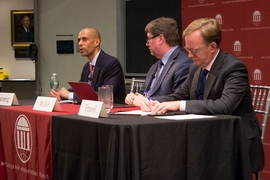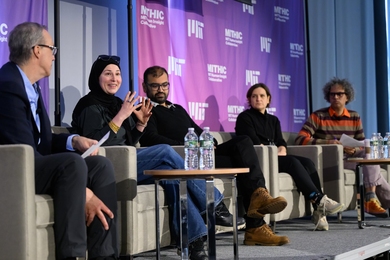In early September, the BRICS group of countries with emerging economies — an informal alliance among Brazil, Russia, India, China, and South Africa — announced it would expand its ranks by six nations. Argentina, Egypt, Ethiopia, Iran, Saudi Arabia, and UAE are now set to join the BRICS group in the near future. This would loosely link together countries representing about 30 percent of global GDP and 43 percent of global oil production, and some experts have speculated about further expansion of the group in the longer term. To discuss the BRICS development, MIT News spoke with M. Taylor Fravel, an expert on China’s foreign policy and security strategy, who is the director of MIT’s Security Studies Program, as well as the Arthur and Ruth Sloan Professor in MIT’s Department of Political Science.
Q: Why is the BRICS expansion happening now?
A: There’s been interest in expanding for a while. The BRICS primarily appeals to the relatively developed economies in the developing world. But there are huge differences in economic and military power within even the five current BRICS countries. What initially brought them together is the idea that they had shared interests, especially in the economic domain. At the same time, some of these countries have desired to increase their influence in the developing world. You can see how China, Russia, and India have been independently engaging Africa in the last decade. So they each have this desire, and then by acting together they may have more heft, perhaps as a grouping that can represent the interests of the developing world. However, the BRICS is not yet a formal international organization. The BRICS is not yet institutionalized, and I don’t know that it ever will be.
Different states may have different motives for joining, too. For Iran, it gives them a lot more diplomatic space. Iran is a very interesting addition because it has been highly sanctioned by the United States, as Russia has been. That begs the question: What can BRICS do with the rest of the world? It may be more of a grouping that seeks to foster interactions among themselves, to enhance their heft vis-a-vis the world’s most advanced industrialized economies.
Q: On that note, given that BRICS is not formally institutionalized, what can it do?
A: Below the level of their [public] statements, a lot of what the BRICS group can actually do remains uncertain. It’s a consensus-based grouping. The more members you add, and the more heterogenous their interests, the harder it will be to reach consensus. China may want to increase its diplomatic heft through the BRICS and maybe its security role in the developing world, whereas others may want to just focus on maximizing their economic interests. Those are very different impulses, which means the larger it gets, the more watered-down decisions or positions are likely to be, if it’s a group that operates by consensus.
I think the purpose ultimately is to show the collective weight of this group such that their interests need to be taken into account by other states, especially in the West. And perhaps to serve as a vehicle to garner more support from the developing world.
Q: What’s the trajectory for additional growth? Could there be more and more BRICS expansion, in coming years?
A: It’s hard to say. One way to think about it is the BRICS is now roughly the G20, but without many advanced industrial economies [and also] Turkey, Mexico, and Indonesia. The BRICS looks like a G20 minus. That suggests it could grow, but then the group becomes even more diffuse because within BRICS, China will have serious disputes with India over the border, and with Indonesia over maritime boundaries [if Indonesia joined]. Saudi Arabia and the UAE are also important security partners with the United States and large recipients of U.S. foreign military sales. Saudi Arabia and Iran, despite their recent rapprochement, have very significant differences. There seem to be a lot of issues that would limit what even the BRICS-plus could do, and even further limit what a BRICS-plus-plus could do if more countries are included.
I suspect it could become one of these groupings with annual summit meetings and meetings at different levels of government that will issue a lot of statements about their collective interests — that is not unimportant. It could also create the basis for creating something more substantial in the future. Yet because it has no secretariat, and the summit meetings are organized and shaped by the host country, the BRICS plus would not be a grouping that China could easily shape unless it was serving as the host.
Q: Speaking of which: How much is the BRICS expansion driven by China, and serving its interests?
A: China is looking to carve out a much stronger leadership role beyond the OECD states, the advanced industrialized economies. There, I think it is approaching the limits of its diplomacy, especially as Europe becomes more concerned about the economic challenge it faces from China. Meanwhile China’s ties with the United States have never been more fractious, certainly since the end of the Cold War, if not since the normalization [of U.S.-China relations] that began in the 1970s. If China is looking for diplomatic support as ties with Europe and the E.U. deteriorate, the rest of the world beyond the OECD states is the place to go. But China is not putting all of its eggs in one basket, either. China is pursuing a diversified approach, including the BRICS, to see what might be most effective and to hedge its bets.
And of course, India also agreed to expand the BRICS, and India and China have a pretty frosty relationship at the moment. And Brazil agreed to expand, and they would like to deepen ties with the United States in the way that India would. All of that suggests there may be limits on how much China can drive the BRICS agenda to serve its own interests. But the BRICS could still pursue this broader goal of creating a sense of momentum around the wider economic interests these countries share.
Q: How should the U.S. respond, if at all? What kind of thinking is needed?
A: A BRICS as a diffuse grouping that is weakly institutionalized, if at all, does not pose a direct or serious threat to U.S. interests. At the same time, it probably underscores that the United States has neglected the interests of some of the states in the grouping. The U.S. has long under-invested in diplomacy as a way to pursue international influence. Yes, the United States has a tremendous amount of soft power despite this under-investment in diplomacy. But China now has more diplomatic missions abroad than the United States does — even though China has fewer bilateral relationships, because it doesn’t have ties with states that recognize Taiwan, and because China doesn’t have diplomatic missions to organizations like NATO and the OECD. Instead, the United States has relied on its military power and our economic heft while diplomacy has received less attention, especially within the developing world.
It’s a reminder that the U.S. needs to think more about how it’s engaging the rest of the world in a way that advances the interests of both [itself and other countries]. I don’t view this as a zero-sum situation. It would be counterproductive for the United States to take a hostile approach to the BRICS, in part because it has friends within it. If you’re thinking strategtically, having friends in the BRICS group is not a bad thing, so a low-key response is probably most effective.









